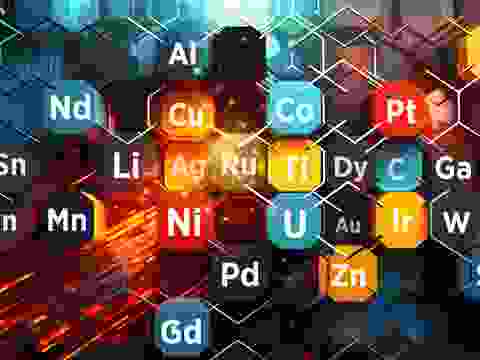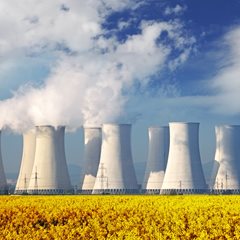U.S. and Ukraine Seal Critical Minerals Deal
Critical minerals, policy, and the energy transition
01 May 2025
Ukraine and United States finalise strategic investment pact aimed at driving national reconstruction, economic recovery, and critical minerals development
On 30 April 2025, Ukraine’s First Deputy Prime Minister and Economy Minister, Yuliia Svyrydenko, travelled to Washington, D.C., to sign a landmark framework agreement on behalf of Ukraine. Signed jointly with U.S. Treasury Secretary Scott Bessent, the agreement establishes a bilateral investment fund designed to finance Ukraine’s reconstruction and develop its critical mineral resources. Following months of intensive negotiations, this long-anticipated accord represents a significant milestone in strengthening Ukraine’s economic recovery and strategic partnership with the United States.
The primary objective of the framework is to accelerate Ukraine’s post-war recovery by creating a joint investment mechanism focused on critical minerals and key economic sectors. It marks a long-term strategic alignment between Kyiv and Washington, combining resources and expertise to rebuild Ukraine’s infrastructure and industrial capacity.
The agreement recognises the significant support the United States has provided since the onset of Russia’s full-scale invasion and formalises a shared commitment to invest in Ukraine’s future. It aims to unlock large-scale U.S. investment in the mining and energy sectors, transforming Ukraine’s mineral wealth, including rare earth elements, into a catalyst for long-term, sustainable growth.
President Volodymyr Zelenskyy has long advocated using Ukraine’s natural resources as a foundation for economic renewal. This agreement begins to realise that vision, underpinned by a clear U.S. commitment to Ukraine’s security, reconstruction, and integration into global markets. U.S. officials have hailed it as a historic economic partnership and a symbol of enduring American support for a sovereign, resilient, and prosperous Ukraine. It also sends a decisive signal to Moscow: those who supported or enabled Russia’s aggression will be excluded from Ukraine’s rebuilding.
Nations that control, process, and secure access to critical minerals will shape the trajectory of clean energy development, economic competitiveness, and national security. Critical minerals lie at the heart of the global energy transition. As countries shift away from fossil fuels towards low-carbon technologies, demand for minerals such as lithium, cobalt, graphite, and rare earth elements is accelerating rapidly. These inputs are essential to everything from electric vehicle batteries and wind turbines to advanced electronics and defence systems.
The agreement between Ukraine and the United States prioritises a range of strategic sectors vital to Ukraine’s recovery and long-term global competitiveness:
-
Critical minerals and mining — Ukraine possesses significant lithium reserves, rare earth elements, and other critical minerals essential to clean energy technologies and advanced manufacturing. Under the new investment framework, funding will be directed towards exploration, extraction, and processing activities. These efforts are expected to position Ukraine as a key supplier in global markets, while also bolstering the resilience of Western supply chains.
-
Oil and gas — Investment will also be channelled into oil and gas projects, focusing on untapped reserves. This includes the development of associated infrastructure, such as pipelines and refineries, which are vital for enhancing Ukraine’s energy security and expanding its export capacity.
-
Infrastructure and energy systems — The agreement will facilitate the rebuilding and modernisation of essential infrastructure, roads, ports, and power grids, required to support resource exports and broader economic activity. These investments aim to restore critical connectivity and lay the foundation for renewed industrial growth.
-
Technology and industrial modernisation — The deal promotes the adoption of modern advanced technologies and international best practices across all targeted sectors. This emphasis on innovation will help increase productivity, raise environmental standards, and accelerate Ukraine’s transition towards a sustainable, knowledge-driven economy.
Key terms of the agreement
The United States–Ukraine mineral agreement marks a landmark in post-war reconstruction and strategic resource cooperation. Structured as a mutually beneficial partnership, the agreement outlines key provisions with significant economic, geopolitical, and security implications. Central to the deal are creating a joint investment mechanism, preferential U.S. access to Ukraine’s critical mineral reserves, and the absence of formal security guarantees. The key terms are summarised below:
-
Joint Investment Fund — A co-managed investment fund will channel capital into Ukraine’s natural resource sectors. Ukraine will contribute 50% of future revenues from newly issued natural resource permits, while retaining full ownership of its assets, including subsoil resources.
-
Preferential U.S. access to resources — The United States is granted preferential access to Ukraine’s critical mineral resources—specifically titanium, lithium, graphite, and uranium—vital to defence, clean energy, and strategic industries. Ukraine alone determines what and where to extract, and ownership of subsoil remains fully Ukrainian.
-
Equal partnership — The Fund is structured on a 50/50 basis and jointly managed, with neither side holding a dominant vote.
-
Protection of national assets — The agreement does not alter privatisation processes or the status of state-owned enterprises such as Ukrnafta and Energoatom, which remain under Ukrainian control.
-
No debt obligations — The agreement imposes no new debt obligations on Ukraine. It focuses on fostering long-term investment and cooperation without financial burden.
-
Compliance and EU alignment — Fully consistent with Ukraine’s Constitution and European integration objectives, the agreement signals reliability and long-term commitment to global partners.
-
Funding sources — The Fund will be financed exclusively from revenues generated by new licences in the critical minerals, oil, and gas sectors. Existing projects and budgeted revenues are excluded.
-
Investment scope and reinvestment policy — The Fund will invest in extraction projects and related infrastructure, with all investment decisions made jointly. Profits are expected to be reinvested in Ukraine for at least the first decade to maximise recovery and growth.
-
Technology Transfer and Investment Promotion — Backed by the U.S. International Development Finance Corporation (DFC), the agreement facilitates the attraction of investment and advanced technologies from the U.S., EU, and other partners. Technology transfer is a central pillar, ensuring Ukraine gains both capital and innovation.
-
Tax exemptions — Fund revenues and contributions are exempt from taxation in both countries, ensuring full reinvestment potential.
-
Additional U.S. contributions — Besides financial investments, U.S. assistance—including military aid—may be counted towards the Fund, strengthening Ukraine’s security and reconstruction capabilities.
Although the agreement deepens U.S.–Ukraine cooperation, it notably excludes explicit security guarantees, and no binding commitments have been included.
Structure and governance of the Reconstruction Investment Fund
The agreement lays out a detailed framework for the operation of the Reconstruction Investment Fund, focused on joint governance, transparent financing, and targeted reinvestment. Key structural elements include:
-
Fund establishment and management — The Fund will be jointly established and equally co-managed by the governments of Ukraine and the United States. The DFC will collaborate closely with Ukrainian authorities to finalise governance and oversee operations.
-
Revenue sources — Ukraine’s contributions will derive from 50% of revenues from new licences in critical sectors. The U.S. may contribute through financial investments and new forms of assistance. Existing projects remain outside the Fund’s remit.
-
Tax-free operation — The Fund’s revenues and contributions will be exempt from taxation in both jurisdictions to maximise impact.
-
Joint decision-making and sovereignty — Governance will be fully collaborative, with joint decision-making processes. Ukraine retains full sovereignty over its resources and state-owned enterprises, with no transfer of ownership or control to foreign actors.
-
Investment policy — The Fund will target investments exclusively within Ukraine, focusing on critical mineral extraction, oil and gas projects, and related infrastructure. Profits will be reinvested for at least the first 10 years, further accelerating Ukraine’s recovery.
-
Legislative alignment — Only limited amendments to Ukraine’s Budget Code are needed to operationalise the Fund. Full ratification will be sought via the Verkhovna Rada.
-
Safeguards against malign actors — The agreement prohibits participation or profit-sharing by any state or entity that supported or supplied Russia’s war effort, reinforcing security and ethical principles.
-
EU compatibility and technology transfer — The agreement aligns with Ukraine’s EU accession roadmap, ensuring compliance with EU legal, environmental, and regulatory standards. The U.S. will support technology and innovation transfer to modernise Ukraine’s industrial and energy systems.
Significance for bilateral economic cooperation
The framework agreement marks a decisive step in forging a long-term strategic partnership between Ukraine and the United States. By replacing fragmented aid with a jointly managed investment structure, it establishes a stable foundation for sustained economic cooperation, underpinned by shared governance and mutual accountability.
At the heart of this partnership is a steadfast commitment to rebuilding Ukraine with full respect for its sovereignty and long-term self-reliance. Unlike traditional aid packages, the agreement does not impose debt burdens. Instead, it offers Ukraine access to investment capital and modern technologies while ensuring transparent, results-driven oversight, giving both nations equal say in how reconstruction funds are allocated, prioritised, and used.
This model reflects a deep alignment of interests. Ukraine benefits from the resources, expertise, and confidence of a key international partner; the United States, in turn, secures a reliable ally at the crossroads of Europe and Eurasia, and gains access to a strategically important supply of critical minerals. This agreement's economic, energy, and security links serve both countries’ long-term national interests.
Beyond its economic impact, the agreement delivers a powerful geopolitical message. It reaffirms Washington’s unwavering support for Ukraine’s independence and Euro-Atlantic aspirations, while making clear that those who enabled or profited from Russia’s aggression will be excluded from Ukraine’s reconstruction. The partnership stands as a tangible expression of solidarity, built not just on values but on joint investment in a peaceful and prosperous future.
Looking ahead, the framework creates opportunities for even deeper integration. It opens the door to future agreements in areas such as defence co-production, agricultural innovation, and renewable energy development. As a model for post-conflict economic cooperation, it may also inspire similar partnerships between Ukraine and other international allies, helping to drive a broader recovery effort that is sustainable, sovereign, and globally connected.
Background and negotiations
Early proposals from the United States included a controversial demand that Ukraine repay $500 billion in aid through future revenues from natural resources, an approach Kyiv rejected as excessive and incompatible with its aspirations for European Union integration. Tensions peaked during a high-stakes meeting between Presidents Trump and Zelenskyy on 28 February, resulting in a temporary breakdown in negotiations. However, subsequent revisions removed the repayment clause and restructured the agreement to better reflect Ukraine’s legal obligations, sovereign rights, and long-term economic sustainability.
The framework agreement signed on 30 April represents a significant turning point in U.S.–Ukraine relations, set against the backdrop of intensifying geopolitical competition. As Washington steps up its sanctions and export controls on China’s critical minerals sector, aimed at countering Beijing’s dominance over global supply chains, the Ukraine deal has taken on added strategic importance. It reflects a broader U.S. effort to diversify mineral sourcing and build resilient, secure supply networks among trusted partners.
One key area of ongoing uncertainty surrounds Ukraine’s eastern and southern territories, where some of the country’s richest deposits of critical minerals, oil and gas, and coal are located. Regions such as Donbas and parts of Zaporizhzhia and Luhansk hold significant concentrations of rare earth elements, titanium, uranium, and other strategic resources. Many of these areas remain under Russian occupation or contested, raising difficult questions about sovereignty, resource control, and legal jurisdiction, issues that are likely to feature prominently in any future peace negotiations. The extent to which Ukraine can fully realise the ambitions of this agreement may depend in part on the eventual resolution of these territorial disputes and the restoration of access to its full mineral wealth.
The finalised agreement offers a balanced, forward-looking framework for Ukraine’s reconstruction, based on shared responsibility and mutual benefit. By prioritising critical minerals, energy, infrastructure, and technological innovation, it supports Ukraine’s immediate recovery and firmly anchors its long-term trajectory within the Euro-Atlantic and wider global economic order. For both nations, the agreement signifies a deepening of economic and strategic ties at a time when control over critical resources is becoming an increasingly central axis of international power.
U.S.–Ukraine Alliance on Critical Minerals and Energy Security
Explore how Ukraine and the United States leverage their mineral assets, policies, and partnerships to position themselves at the forefront of the energy transition.
Critical sectors using strategic minerals




Meet the Critical Minerals team
Trusted advice from a dedicated team of experts.

Henk de Hoop
Chief Executive Officer

Beresford Clarke
Managing Director: Technical & Research

Jamie Underwood
Principal Consultant

Dr Jenny Watts
Critical Minerals Technologies Expert

Ismet Soyocak
ESG & Critical Minerals Lead

Thomas Shann Mills
Senior Machine Learning Engineer

Rj Coetzee
Senior Market Analyst: Battery Materials and Technologies

Franklin Avery
Commodity Analyst
Brought to you by

Jamie Underwood
Principal Consultant

How can we help you?
SFA (Oxford) provides bespoke, independent intelligence on the strategic metal markets, specifically tailored to your needs. To find out more about what we can offer you, please contact us.



















